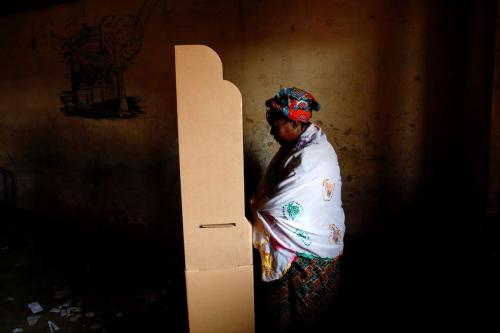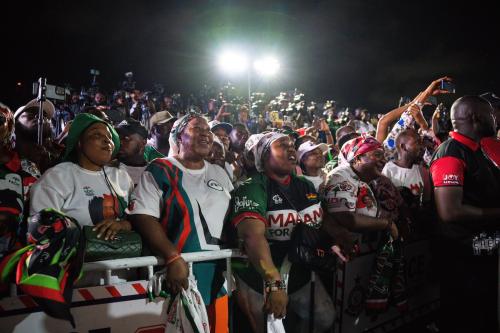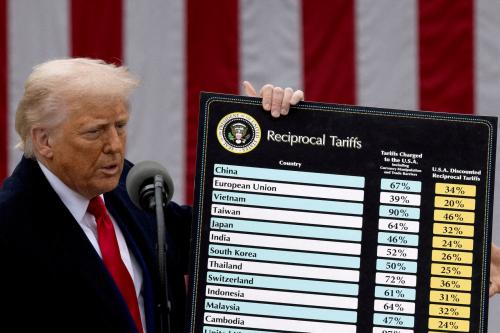This week Europe celebrates the 70th anniversary of the Victory in Europe (V-E) Day, and it is worth remembering a crucial lesson of post-crisis conduct on such occasions: winning the war does not mean winning peace. Consolidating peace and stability, and promoting reconciliation and prosperity, requires working together toward building an economic system of shared and interdependent wealth.
Take World War I, a quarter-century prior to V-E Day. While historians still debate the verdict on the post-war settlement, some general characteristics are undisputed. Negotiations after World War I primary focused on territorial adjustments, reparations, and assigning war guilt. They crucially lacked mechanisms for an equitable economic settlement to consolidate the post-war order. No institutional instruments were built to foster a stable, integrated, and international economic and political system. More astute observers of this post-war settlement—notably John Maynard Keynes, who championed multilateral mechanisms and instruments—expressed the fear that in the absence of such institutions peace lay on a weak foundation. Europe was back on the battlefields within two decades.
At the end of World War II, the victorious Allies demonstrated that humankind does learn from history, if sometimes the hard way. The collaborative institutions and mechanisms of the post-war order started being put together even before the war ended, and Keynes became one of their main architects. In July 1944, 10 months before V-E Day, the Bretton Woods conference laid the foundation of this new economic order, including the creation of what were to become the International Monetary Fund and the World Bank (its first loan being to France for reconstruction purposes). In the coming years, post-war reconstruction and development received major new boosts with the Marshall Plan (in which Brookings played a major role) and the creation of the first common European institutions that were to evolve into the European Union.
The result was an unparalleled 30-year economic boom, known in Western Germany as the “Wirtschaftswunder” and in France as the “Trente Glorieuses,” which transformed Western Europe from a war-ravished wasteland into a prosperous and democratic community of nations.
However, unfinished business remained. The eastern part of the continent remained behind the iron curtain of the Soviet political and economic bloc. Some successes were achieved in post-war reconstruction, industrialization, and living standards, but this was done through the mechanisms of a closed communist command economy in isolation from the wider global economic system. As a result, by the late 1970s the Soviet bloc increasingly showed tensions from its internal contradictions. A decade later the system collapsed.
Later came the fall of the Berlin Wall. Many major statesmen were surprised, but they knew that the post-World War II lessons needed to be applied in dealing with what came next. The prime task would be integrating the former Soviet bloc countries into the international economic system; creating mechanisms for economic transition to free markets; and laying the basis for sustainable economic growth. This would help consolidate political pluralism and democracy.
A key tool in this economic transition process was the European Bank for Reconstruction and Development (EBRD). First mentioned just after the 1989 revolutions, the EBRD came into being in 1991. Its mandate—contributing to economic progress by fostering the transition towards open, market-oriented economies in countries committed to multiparty democracy—makes it the only international financial institution with a political mandate.
Today, 25 years later, the EBRD is still investing in economic transition; last year alone its investments totalled almost 9 billion euros. It has made a significant contribution to promoting economic and political pluralism, and improving the lives of people from Morocco to Mongolia. It has also accumulated significant knowledge for handling such major transition efforts.
The EBRD has become the largest single investor in central and Eastern Europe and central Asia. Its impact goes beyond just investment volume by combining sector expertise with in-depth knowledge of economic, social, and political conditions in each country. The EBRD also stimulates foreign direct investments, acting as a catalyst for accessing additional equity, debt, and trade finance (for every EBRD euro invested, an additional 2.5 euros is contributed by co-investors). The EBRD has a proven track record of financing with major international companies like Danone, Fiat, Procter & Gamble, Vivendi, and Daimler among others.
Twice in the past decade the EBRD’s expertise in economic transition has been recognized. First, in the aftermath of the 2008 financial crisis, the EBRD doubled lending volumes to help its recipient countries deal with the economic and financial fallout. Second, the bank extended its geographic scope to help the economic and political transitions in Southern and Eastern Mediterranean countries, applying the valuable transition lessons learned in the post-communist region.
Yet seven decades after V-E Day, there is still unfinished business. Several countries in Europe remain “stuck in transition” with convergence to the income levels of Western economies remaining an elusive goal. The latest recession further frustrated the region’s growth aspirations, blowing dark winds in the sails of populist parties, and propagating disengagement from multilateral institutions and narrower nationalistic paths to prosperity. The spectre of geopolitical conflict has made an unwelcome return in the eastern part of Europe, and terrorism and extremism have risen in the south.
In the face of such developments, it’s worth reflecting on the key lesson of V-E Day and its aftermath. Durable peace and stability can only be achieved and maintained through:
- Creating shared wealth
- Making economies linked and symbiotic
- Tackling unacceptable inequality in the distribution of wealth and systemic risks, like climate change
Today, the role and significance of multilateral institutions like the EBRD has to be seen in this broad context. The need for multilateral cooperation for economic prosperity, reconstruction, and development remains urgent.
The Brookings Institution is committed to quality, independence, and impact.
We are supported by a diverse array of funders. In line with our values and policies, each Brookings publication represents the sole views of its author(s).




Commentary
Lessons from V-E Day in Europe and its aftermath
May 7, 2015